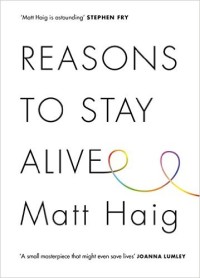We find ourselves through the process of escaping
 Reasons to Stay Alive
Reasons to Stay Alive
by Matt Haig
I had come across some very smart, funny, insightful blog posts by Haig that had put him on my to-read list, so when I saw that he was going to be at Toppings bookshop in Bath, I suggested to Tim that he might want to buy me tickets to the event. I am a helpful gift-receiver that way.
This book is a few things at once – it’s part memoir, part essay, part self-help – with depression as its subject. Haig said that the reader he had in mind was himself aged 25 having his first terrifying experience of depression and anxiety. So the chapters are short, the factual bits are never condescending, the literary quotes on the topic are accessible; it’s all very readable.
But most importantly, the trajectory of the book is upward. There is no “before” – the story starts at Haig’s rock bottom, aged 25 and not understanding at all what was happening to him. From there it is largely, though not entirely, chronological so that we end with Haig’s current state, which is that of course he still has depression but he has lots of ways to deal with it, he knows the bad times pass, and he is even thankful in some ways for having depression – for one, it made him a writer.
“I didn’t totally fit in. I kind of disintegrated around people, and became what they wanted me to be. But paradoxically, I felt an intensity inside me all the time. I didn’t know what it was, but it kept building, like water behind a dam. Later, when I was properly depressed and anxious, I saw the illness as an accumulation of all that thwarted intensity. A kind of breaking through. As though, if you find it hard enough to let yourself be free, your self breaks in, flooding your mind in an attempt to drown all those half-failed versions of you.”
Like Haig, I am allergic to the label “self-help”, but if there was ever a group of people who need help it’s anyone with depression and/or anxiety – particularly young sufferers. This book offers bucketloads of reassurance, lays down facts squarely and honestly, and offers guidance to the family and friends of sufferers as well.
Haig makes it clear that his experience of depression and anxiety is not universal – no-one’s is – he simply uses his life as a lens to demonstrate that there are, as the title (and Twitter hashtag) suggests, #reasonstostayalive. Depression lies and distorts, but it also passes. And Haig is also clear that the things that have helped and hindered him will not be the same for every sufferer.
One of the things I love about this book is that books are an important part of the story. Haig is an English lit graduate, so he was already a reader, but during his recovery from his first major depressive period, he turned to books voraciously.
“There is this idea that you either read to escape or you read to find yourself. I don’t really see the difference. We find ourselves through the process of escaping…If there is a way out, a way that isn’t death itself, then the exit route is through words.”
I surprised myself by even liking the lists that are sprinkled through the book. They are somehow both earnest and gently funny. For example, the list titled “How to live (forty pieces of advice I feel to be helpful but which I don’t always follow)” includes such items as “Beware of Tuesdays” but also “Don’t feel guilty about being idle. More harm is probably done to the world through work than idleness.” And I think I might heart Haig a bit for including in a list of beautiful things to notice: “some graffiti, a wind farm”.
It’s a small book and doesn’t take long to read, but it has stayed with me and I suspect will continue to do so.
Published 2015 by Canongate.
Source: Toppings Bookshop, Bath.